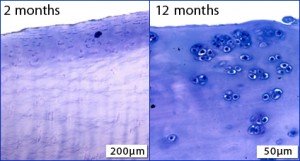Special Report: CABMM: Cartilage repair and regeneration

Cartilage regeneration is probably one of the most challenging adventures in modern medicine and occupies thousands of scientists all over the world. While modern molecular techniques allowed the elucidating of molecular mechanisms and pathways of cartilage degeneration in many ways, results become a bit scarce when successful cartilage regeneration is attempted.
Modern scaffolds based on synthetic and natural substances, cartilage cells as well as the use of macromolecules, such as hyaluronan, are applied in experimental studies and sometimes result in promising hyaline-like cartilage structures. However, at the time of writing this feature, nobody in the world was able to come up with a technology, or method, that permanently replaces cartilage with the original hyaline structure that is able to withstand the mechanical forces long term. At the end of the cascade we are still left with osteoarthritis and, in many cases, finally with surgical joint replacements.
One of the reasons, believes Prof Brigitte von Rechenberg from the Musculoskeletal Research Unit (MSRU) at the Vetsuisse Faculty of Zurich, University of Zurich, is that – in contrast to the bone field – cartilage remodelling under physiological and normal conditions is practically unknown. In her logic it seems inevitable to understand this basic mechanisms before any progress can be made in cartilage regeneration.
Clear connection
Usually researchers look at either the cartilage or the bone. Moreover, there are still textbooks available that deny a connection between the subchondral bone and overlying cartilage, although in foetal and even early embryonic life they are clearly connected. In addition, it is still not understood why a tear in hyaline cartilage cannot heal and is always the start of cartilage degeneration that cannot be halted.
Prof von Rechenberg dedicates her research to this problem of cartilage remodelling. In her experimental work with stifle joints of sheep, her research team showed that the (dead) cartilage of pretreated photo-oxidised osteochondral grafts was repopulated with living cells stemming from the subchondral bone.
Cells penetrated the calcified cartilage zone and grew into the dead cartilage matrix while synthesising a new matrix. At the same time, pannus formation at the surface of the photo-oxidised cartilage was observed, where cells proliferated and migrated into the deeper zones of the cartilage surface. Last, the methylene blue of the photo-oxidised graft diffused into the adjoining living cartilage and inhibited cartilage degeneration of the edges.
In selected circumstances, cartilage resurfacing was possible with photo-oxidised osteochondral grafts, where union between the adjoining cartilage and graft was observed. In consecutive experiments, a metaphyseal defect in the proximal tibia of 136 sheep resulted in complete degeneration of the overlying cartilage already after 14 days, which partially recovered over time (3, 6 and 12 months) depending on the biomimetic used to enhance bone healing of the metaphyseal defects.
Latest experiments with this animal model in sheep showed that the transcutaneous delivery of a non-steroidal anti-inflammatory drug by means of the MedDrop technology slowed down cartilage degeneration in general and most interestingly seemed to prevent degeneration of cartilage edges in case of a lesion at the cartilage surface. In fact, the edges appeared as sealed together and cells were found in what seemed to be a reparative process to heal the lesion.
It is thought that, apart from the NSAID, the oxygen carrier was part of improved cell proliferation and sealing of the edges. Although true cartilage healing may still not be possible at this point, these experiments reveal important insights into the mechanisms of cartilage remodelling and regeneration and – one day – may allow an adapted and innovative approach to an old problem.

Prof Dr med Dr rer nat Simon P Hoerstrup
Swiss Center for Regenerative Medicine
Regenerative Medicine Programme
University Hospital and University Zurich
tel: +41 (0)44 255 3801
+41 (0)44 634 5609
Email Swiss Center for Regenerative Medicine